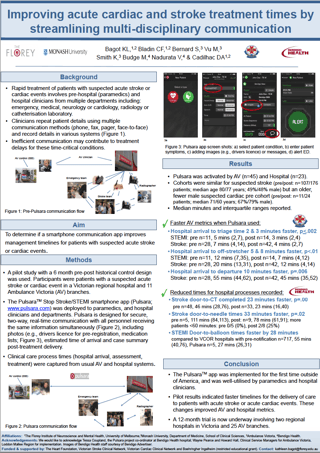Pulsara Around the World - 2025 Recap and January 2026
December Recap After an incredibly busy events year with 102 conferences, trade shows, and sponsorships, December was on the slower side for us, with...
2 min read
 Hannah Ostrem
:
Dec 07, 2017
Hannah Ostrem
:
Dec 07, 2017
![Australian Health Systems Reduce D2B and D2N Times by 28 and 33 Minutes Respectively [Preliminary Research]](https://www.pulsara.com/hubfs/Screen%20Shot%202017-12-07%20at%202.11.50%20PM.png)
To determine if Pulsara can improve management timelines for patients suspected of having a stroke or cardiac event, researchers in Australia have conducted a pilot study with a 6 month pre-post historical control design.
The researchers give the following background to the study:
 To see if Pulsara could help stop the inefficient communication the teams were experiencing -- and thereby reduce associated treatment delays -- the researchers had prehospital clinicians as well as hospital users activate Pulsara for suspected stroke and STEMI cases.
To see if Pulsara could help stop the inefficient communication the teams were experiencing -- and thereby reduce associated treatment delays -- the researchers had prehospital clinicians as well as hospital users activate Pulsara for suspected stroke and STEMI cases.
In suspected stroke patients, the cohorts were similar (pre/post: n=107/176 patients; median age 80/77 years; 49%/48% male), but in suspected cardiac patients, the cohort was older, and more female (pre/post: n=11/24 patients; median 71/60 years; 67%/79% male).
Key care time metrics including hospital arrival, assessment, and treatment were recorded from Ambulance Victoria and the hospital systems in the Victoria area.
Authors found that for STEMI patients, door to triage time was 2 minutes faster with Pulsara, and the same metric was 3 minutes faster for stroke patients, p<.002 STEMI: pre n=11, 5 mins (2,7), post n=14, 3 mins (2,4) Stroke: pre n=28, 7 mins (4,14), post n=42, 4 mins (2,7)
The teams also found that door time to off-stretcher times were 5 minutes faster in STEMI patients and 8 minutes faster for stroke patients when Pulsara was used, p<.01 STEMI: pre n=11, 12 mins (7,35), post n=14, 7 mins (4,12) Stroke: pre n=28, 20 mins (13,31), post n=42, 12 mins (4,14)
In addition, EMS crews reported that hospital arrival to departure was 10 minutes faster with use of the app, p=.006
Hospital teams also found that for stroke, door-to-CT was completed 23 minutes faster, p=.00 pre n=48, 46 mins (28,76), post n=33, 23 mins (16,40). Stroke door-to-needle times were also 33 minutes faster, p=.02 pre n=5, 111 mins (84,113), post: n=9, 78 mins (61,91); more patients <60 minutes: pre 0/5 (0%), post 2/8 (25%)
For STEMI, door-to-balloon times were faster by 28 minutes compared to hospitals with pre-notification n=717, 55 mins (40,76), Pulsara n=5, 27 mins (26,31).
The Australian hospital and pre-hospital facilities are the first International sites to implement Pulsara, and the preliminary results of their study indicate reductions in key time metrics for treatment of patients with stroke or acute cardiac events. Two regional hospitals in Victoria and 25 Ambulance Victoria branches are currently conducting a 12-month trial.

December Recap After an incredibly busy events year with 102 conferences, trade shows, and sponsorships, December was on the slower side for us, with...

Editor's Note: In July 2025, EMS1 and Fitch & Associates released their annual EMS trend survey, What Paramedics Want, proudly sponsored by Pulsara....
![[PRESS RELEASE] Published Research Finds Up to 31% Faster STEMI Treatment Times in Rural Hospital Setting with Pulsara](https://www.pulsara.com/hubfs/_1_website-page-blog-assets/pulsara-hosp-teams-assign-cardio-stemi-rn-1200x701.jpg)
Published research shows how using Pulsara, alongside standardized field activation and a focus on stakeholder relationships, improves STEMI care and...